In the charming state of Iowa, the vibrant and diverse avian population adds a touch of natural elegance to the landscape.
Among the numerous feathered residents, hummingbirds are delicate and captivating creatures. Iowa is home to at least five enchanting species of hummingbirds, each contributing its unique charm to the local ecosystem.
These tiny, iridescent wonders bring a splash of colour and energy to the Hawkeye State as they flit gracefully from flower to flower, sipping nectar with their needle-like bills.
Exploring the presence of these five hummingbird species in Iowa unveils a fascinating aspect of the state’s rich biodiversity and highlights the significance of preserving habitats to ensure the continued enchantment of these delightful aerial acrobats.
Features of Hummingbirds in Iowa
Hummingbirds, those delicate and enchanting avian creatures, add a touch of magic to Iowa’s natural landscape. These tiny marvels, with their iridescent plumage and rapid, darting flights, boast an array of features that make them truly remarkable.
As we delve into the unique characteristics of hummingbirds in Iowa, six distinct features come to the forefront, each contributing to the charm and adaptability of these captivating birds.
Vibrant Plumage
Iowa’s hummingbirds showcase a dazzling array of colours, with shades of iridescent greens, blues, and even hints of vibrant reds and purples.
Their shimmering plumage is an aesthetic delight and crucial in attracting mates and defending territories.
Hovering Abilities
One of the most mesmerizing features of hummingbirds is their unparalleled ability to hover mid-air, achieved through rapid wing beats.
This extraordinary skill allows them to access nectar from flowers precisely, showcasing a balletic performance that distinguishes them from other bird species.
Specialized Bills
Hummingbirds possess long, slender bills adapted for sipping nectar from tubular flowers.
This specialized tool allows them to access the energy-rich reward with remarkable efficiency, showcasing the intricate evolution of their feeding apparatus.
Energetic Metabolism
To sustain their high-energy lifestyle, hummingbirds exhibit an astonishing metabolism.
They must consume large amounts of nectar daily, often feeding every 10 to 15 minutes. This constant need for fuel propels their frequent visits to various nectar sources.
Migratory Prowess
Iowa is a temporary haven for migratory hummingbirds, including the Ruby-throated and Rufous species.
The remarkable migratory journeys of these tiny birds, spanning thousands of miles, highlight their navigational prowess and adaptability to diverse ecosystems.
Territorial Behavior
Despite their small size, hummingbirds are known for their territorial nature. They fiercely defend feeding areas and may use acrobatic aerial displays to deter intruders.
This territorial behaviour reflects their commitment to securing essential food resources.
The features of hummingbirds in Iowa contribute to their unique role in the state’s ecosystem, showcasing a delicate yet resilient presence that adds an extra layer of wonder to the natural world.
5 Hummingbirds in Iowa
Whether you’re a seasoned birdwatcher or a casual observer, this exploration promises to unveil the beauty and diversity of hummingbirds in Iowa, offering a glimpse into their extraordinary lives and the ecosystems they inhabit.
1. Ruby-throated Hummingbird
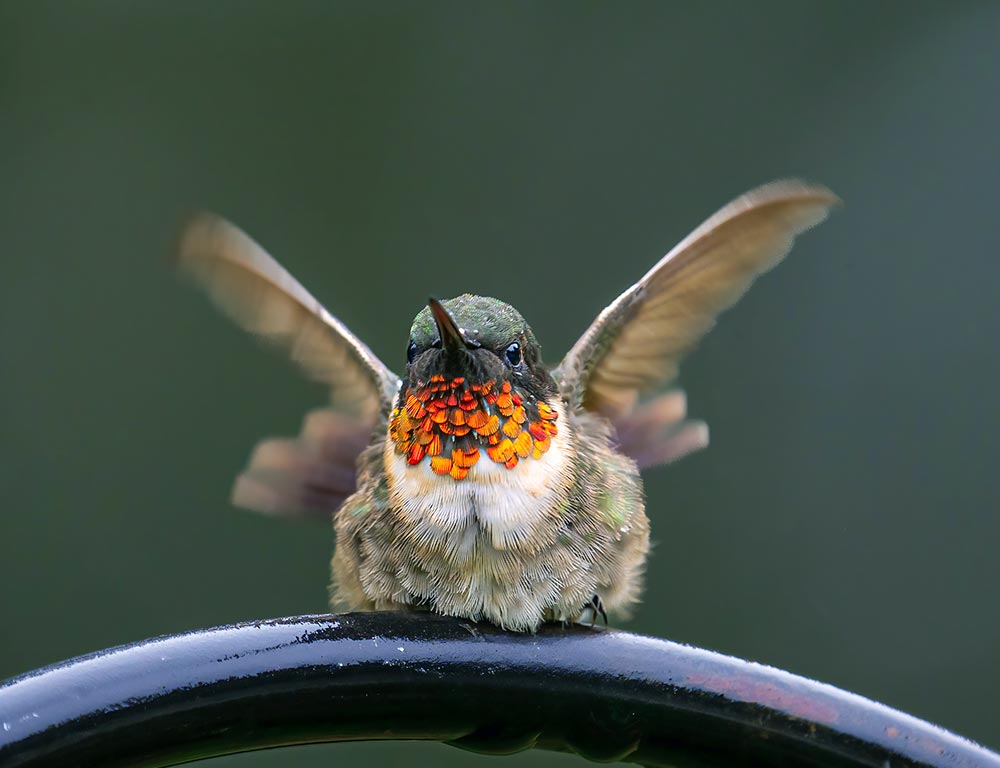
- Scientific Name: Archilochus colubris
- Category: Eastern North American Migrant
- Life Span: 3 to 5 years
- Size: 3 to 3.5 inches
- Weight: Approximately 0.1 to 0.2 ounces
- Food: Primarily nectar, supplemented with insects and spiders
- Wingspan: 3 to 4 inches
The Ruby-throated Hummingbird, a dazzling visitor to Iowa, is the only species commonly found in the eastern United States.
Identified by its brilliant iridescent green plumage, the males sport a vibrant ruby-red throat patch, adding to their visual allure.
With 3 to 5 years of life, these agile birds embark on an impressive migratory journey, covering up to 18 hours of non-stop flight across the Gulf of Mexico.
Their diet primarily consists of nectar from various flowers, making them vital pollinators.
2. Rufous Hummingbird
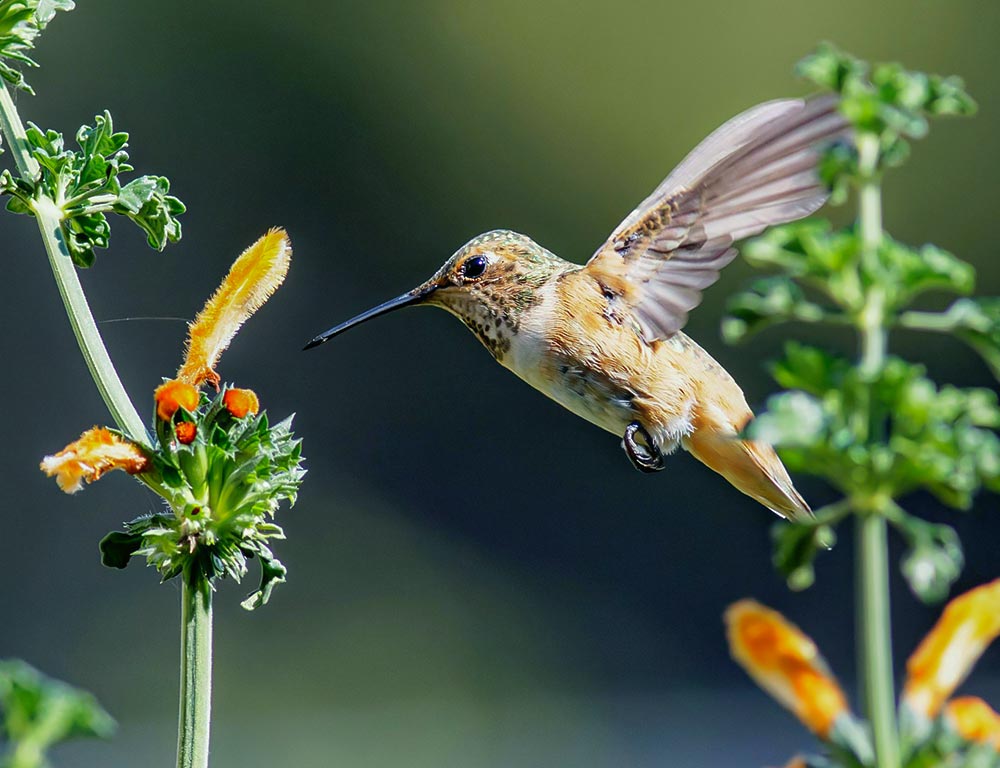
- Scientific Name: Selasphorus rufus
- Category: Western North American Migrant
- Life Span: 3 to 5 years
- Size: 2.8 to 3.5 inches
- Weight: Approximately 0.1 to 0.2 ounces
- Food: Nectar, supplemented with insects and spiders
- Wingspan: 4 to 4.3 inches
With its striking orange-red plumage and impressive migratory feats, the Rufous Hummingbird graces Iowa as a western migrant. These tiny birds, spanning 2.8 to 3.5 inches in size, possess an adventurous spirit, annually travelling remarkable distances.
Despite their diminutive stature, they display territorial aggression and defend feeding sites vigorously.
With a diet primarily composed of nectar and supplemented by insects, Rufous Hummingbirds play a crucial role in pollination, highlighting their ecological significance in the diverse hummingbird tapestry of Iowa.
3. Anna’s Hummingbird
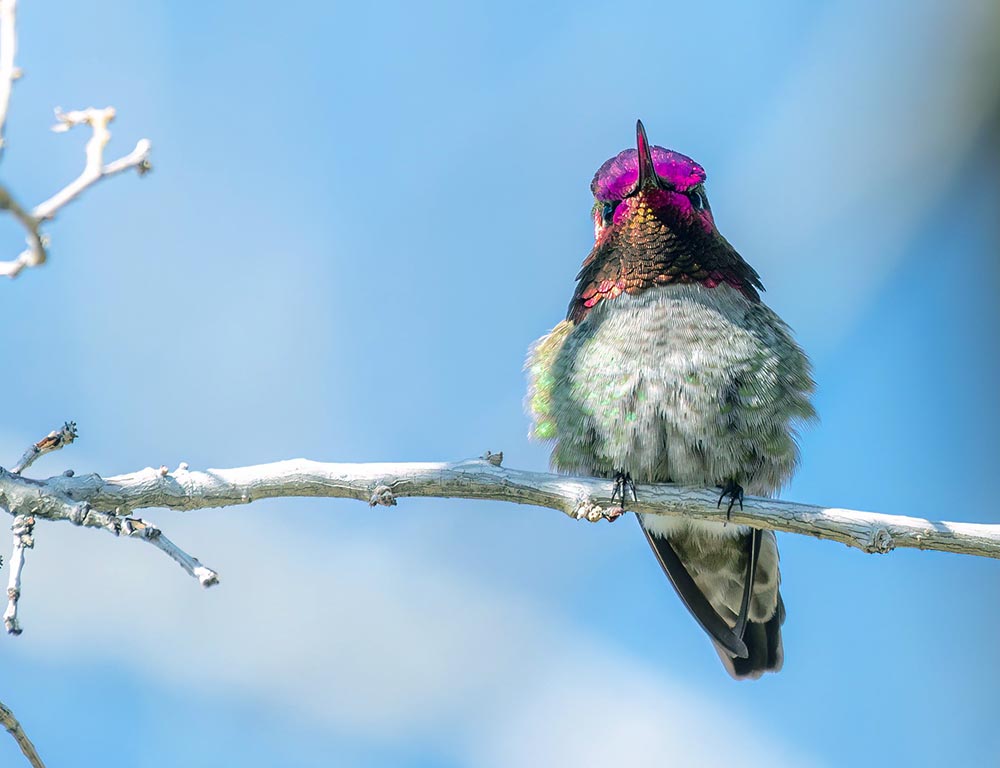
- Scientific Name: Calypte anna
- Category: West Coast Resident
- Life Span: Up to 5 years
- Size: 3.9 to 4.3 inches
- Weight: Approximately 0.1 to 0.2 ounces
- Food: Nectar, supplemented with small insects
- Wingspan: 4.7 to 5.1 inches
Anna’s Hummingbird, a resilient West Coast resident, ventures into Iowa’s landscape. Easily identified by the males’ iridescent rose-pink throats and crowns, these hummingbirds exhibit remarkable territorial behaviour.
With a life span of up to 5 years, Anna’s Hummingbirds are known for their year-round residency and resistance to colder temperatures. Their diet, primarily consisting of nectar and supplemented with small insects, underscores their adaptability.
Witnessing Anna’s Hummingbirds in Iowa provides a unique glimpse into the lifestyles of these resilient, colourful inhabitants, contributing to the state’s rich hummingbird diversity.
4. Broad-billed Hummingbird
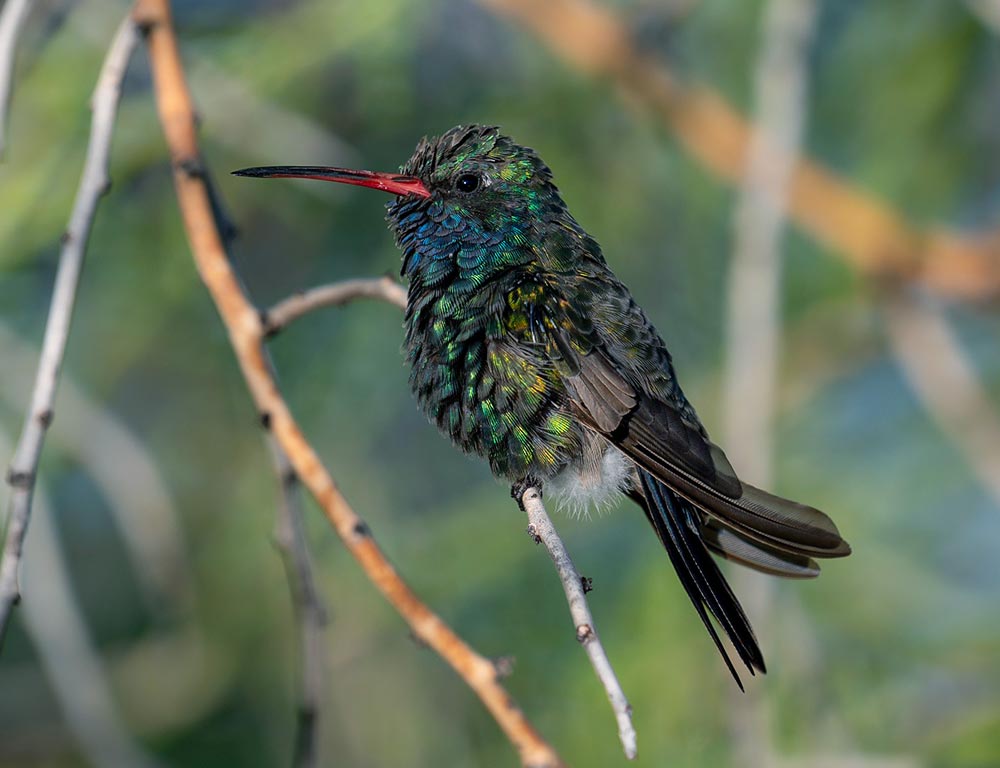
- Scientific name: Cynanthus latirostris
- Category: Small bird, part of the Trochilidae family
- Life span: 3 to 5 years
- Size: 3.5 to 4 inches
- Weight: Approximately 3 to 6 grams
- Food: Nectar, supplemented with insects
- Wingspan: 4 to 4.3 inches
The Broad-billed Hummingbird, characterized by its striking iridescent blue and green plumage and, as the name suggests, its broad and straight bill, is a captivating species found in the southwestern United States and northern Mexico.
Although less commonly sighted in Iowa, occasional sightings make for exciting birdwatching experiences. These hummingbirds exhibit territorial behaviour, often defending their chosen feeding areas with remarkable agility.
With a preference for nectar-rich flowers, the Broad-billed Hummingbird may also consume insects to supplement its diet. Its vibrant colours and acrobatic flights add a touch of exotic allure to Iowa’s birdwatching landscape.
5. Mexican Violetear
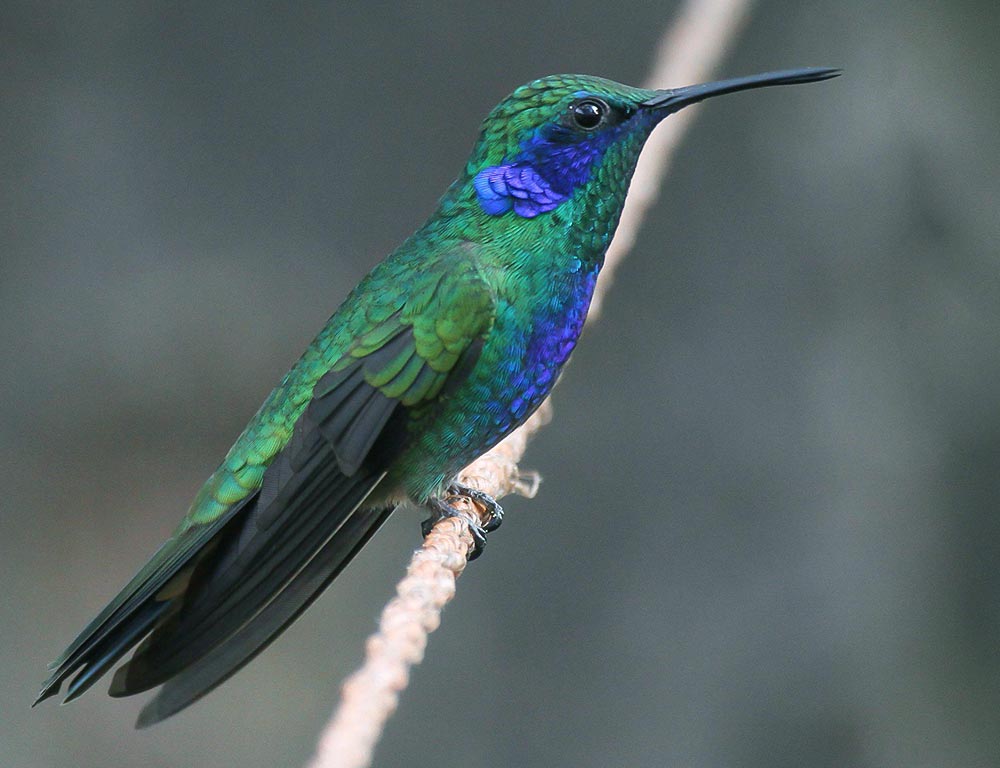
- Scientific name: Colibri thalassinus
- Category: Medium-sized bird, part of the Trochilidae family
- Life span: 3 to 5 years
- Size: 4 to 4.3 inches
- Weight: Approximately 5 to 9 grams
- Food: Nectar, supplemented with insects
- Wingspan: 5 to 5.3 inches
The Mexican Violetear, adorned with vibrant green plumage and a distinctive violet-blue patch behind its eye, is native to Mexico and parts of Central America.
While less common in Iowa, occasional sightings make it a sought-after gem for bird enthusiasts. These hummingbirds are known for their voracious appetite, requiring frequent visits to flowers and feeders to sustain their energy.
Agile and territorial, the Mexican Violetear engages in spirited aerial displays, defending its feeding grounds.
With a preference for tubular flowers that provide ample nectar, this species contributes a touch of tropical beauty to the occasional hummingbird sightings in Iowa, showcasing the diversity of these remarkable avian creatures.
When and Where to See Hummingbirds in Iowa
Iowa’s hummingbirds bring an ethereal touch to the landscape, and knowing when and where to witness these delightful creatures can enhance your nature-watching experience.
Timing is Everything
Hummingbirds typically migrate to Iowa during the warmer months, making late spring to early fall the prime time for observation.
Arrival can vary, with May marking the beginning of their presence and September signalling their departure. Plan your hummingbird-watching adventure accordingly to maximize sightings during these peak months.
Backyard Bliss
Transform your backyard into a hummingbird haven by strategically placing feeders and cultivating hummingbird-friendly flowers.
Choose various nectar-producing plants like bee balm, salvia, and trumpet vines. Hang feeders at varying heights to accommodate these agile fliers, providing a reliable food source that encourages their return.
Nature Reserves and Parks
Explore Iowa’s diverse landscapes in state parks, nature reserves, and botanical gardens. Locations with a mix of open spaces and vibrant flora are ideal for spotting hummingbirds.
Places like Effigy Mounds National Monument and the Dubuque Arboretum & Botanical Gardens blend natural beauty and a welcoming habitat for these aerial wonders.
Migration Hotspots
Stay informed about hummingbird migration patterns in Iowa. Follow local birdwatching communities and resources to discover hotspots where these delightful birds gather during their journey.
Watch reports and join fellow enthusiasts in popular migration locations for an immersive experience.
Weather Awareness
Hummingbirds are more active on warm, sunny days. Plan your outings during favourable weather conditions to increase the likelihood of witnessing their vibrant displays.
Mornings and late afternoons are often peak times for hummingbird activity, as they forage for nectar to fuel their high metabolism.
Patience and Observation
Hummingbirds are fast and may not appear on cue. Cultivate patience and enjoy the serene moments in nature.
Find a comfortable spot armed with binoculars and a camera, and observe their mesmerizing flights, distinctive colours, and territorial antics.
Iowa offers a delightful opportunity to witness hummingbirds in various settings.
Whether in your backyard or exploring natural reserves, understanding their behaviour, preferred habitats, and the timing of their migration enhances the chances of creating memorable encounters with these enchanting creatures.
Wrapping Up
The delicate flutter of hummingbird wings echoes through the landscapes of Iowa, adding a touch of magic to the state’s natural tapestry.
As we’ve delved into the lives of these five enchanting species, it becomes evident that Iowa’s biodiversity is intricately connected to the vibrancy of these aerial jewels.
The fragility of their existence underscores the importance of conservation efforts to preserve the habitats that sustain them.
Witnessing the aerial ballet of hummingbirds in Iowa offers a visual spectacle and serves as a poignant reminder of our collective responsibility to protect and cherish the diverse ecosystems that these tiny wonders call home.